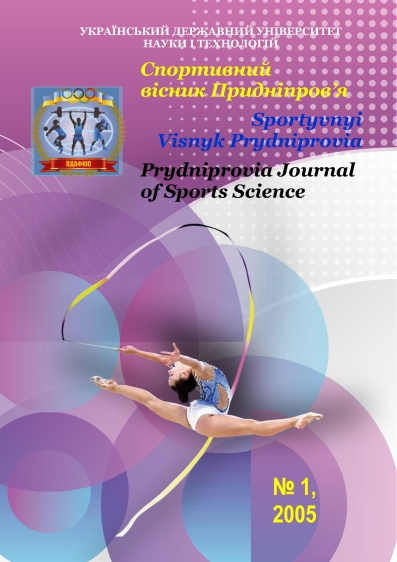Features of self-assessment of the physical self-image in applicants for higher education, considering their professional orientation
DOI:
https://doi.org/10.32540/2071-1476-2025-1-087Keywords:
self-esteem, physical fitness, physical image of “I”, students, applicants for higher educationAbstract
Introduction: This article aims to analyze the key trends, characteristics, and variability of self-perception of physical image among students, taking into account their professional orientation. The research objective is to identify the specific features of self-perception of physical image among students of higher educational institutions with different professional orientations.
Materials and Methods: The experiment was carried out on the basis of three colleges of higher professional education: Ivan Piddubnyi Olympic Professional College; Ivano-Frankivsk Professional College of Physical Education; Kyiv Professional College of Communications. A total of 365 respondents (217 boys and 148 girls) took part in the study. To solve the set tasks we used a complex of methods: theoretical (comparative method of comparison and analysis of domestic and foreign experience on the studied problem); psychological (for the study of self-assessment of physical fitness of respondents we used an adapted version of the questionnaire “Self-assessment of physical development” on the basis of the Australian personal questionnaire “Physical Self-Description Questionnaire” by Marsh H.W.); generally accepted methods of mathematical statistics.
Results: The obtained results of the study indicate significant differences in the perception of their own body and health among college students of different professional orientations and demonstrate gender differences in the self-esteem of applicants. It has been found that young men more often have a high level of self-esteem than girls. It has been found that all assessments of aspects of the physical self-differ statistically significantly (p<0.05) between students studying at different colleges. The greatest differences are observed in such indicators as physical activity and strength. Slightly smaller, but also significant differences are demonstrated by the subjects in terms of general self-esteem, coordination of movements and sports abilities.
Conclusions: Professional orientation is one of the most important determinants of self-esteem of the physical self. Students majoring in physical education and sports demonstrate a higher level of physical self-efficacy, while students of other specialties are influenced by various psychosocial factors.
References
Humeniuk OYe. Psychology of self-concept. Ternopil: Ekonomichna dumka; 2004. 310 p
Deci EL Ryan RM. Promoting optimal motivation and psychological well-being across life domains. Canadian Psychology. 2008;49(1):14-23
Kryvoruka YeV Lupiyko LV. Theoretical analysis of the image of the physical “I” in psychological science. Naukovi perspektyvy. 2024;(10(52)):86-89. https://doi.org/10.52058/2708-7530-2024-10(52)
Krucevych T, Marchenko O. Self-assessment of features and adequacy of physical development of young men in urban and rural areas. Fizychne vykhovannia, sport i kultura zdorovia suchasnomu suspilstvi. 2021;(2(54)):69-78. https://doi.org/10.29038/2220-7481-2021-02-69-78
Levytska IM. Influence of the image of the physical “I” on self-attitude and personality development in early adolescence. Young scientist. 2017;(3):267-71. Available from: http://nbuv.gov.ua/UJRN/molv_2017_3_64
Lipkovska Yu. Formation of adequate self-esteem in schoolchildren. Psykholohichni vymiri kultury, ekonomiky, upravlinnyat. 2016;(9):61-69
Marchenko O. Theoretical and methodological foundations of the gender approach to the formation of the axiological significance of physical education of schoolchildren: a monograph. Pereiaslav-Khmelnytskyi: Dombrovska Y.M.; 2018. 292 p.
Marchenko OYu, Moskalenko OV. Research of self-assessment of physical development of athletes in the context of gender approach. Sportivna medytsyna, fizychna terapiya ta ergoterapevtyka. 2023;(2):43-8. https://doi.org/10.32652/spmed.2023.2.100-104
Marsh KhV, Shavelson R. Self-concept: its multifaceted hierarchical structure. Educational Psychologist. 1985;20(3):107-23. https://doi.org/10.1207/s15326985ep2003_1
Onufriyeva LA. Self-esteem as a component of the self-concept of future specialists. Problemy suchasnoi psykholohii. 2013;(22):396-412
Pospelova ID, Kosyanova OYu. Psychological bases of training psychologists to form a positive image of the physical self in adolescents. Science and Education. 2017;(11):60-64
Shynkaruk VI, et all, editors. Filosofskyi entsyklopedychnyi slovnyk. Kyiv: Abris; 2002
Furman AV, Humeniuk OS. Psychology of the self-concept. Lviv: Novyi Svit-2000; 2006. 360 p
Byshevets N, Andrieieva O, Goncharova N, Shynkaruk O, Hakman A, Usuchenko V, Synihovets I. General regression modeling of the impact of physical activity on stress-related states in higher education students during military conflict. Journal of Physical Education and Sport. 2024;24(9): 1147-58
Deci EL, Ryan RM. The “what” and “why” of goal pursuits: Human needs and the selfetermination of behavior. Psychological inquiry. 2000;11(4):227-68
Fox KR. The physical self-perception profile manual. Human Kinetics, Champaign; 1997. p. 111-40
Fox KR, Corbin CB. The physical self-perception profile: Development and preliminary validation. Journal of Sport and Exercise Psychology. 1989;11(4):408-30. https://doi.org/10.1123/jsep.11.4.408
Holland, G., & Tiggemann, M. A systematic review of the impact of the use of social networking sites on body image and disordered eating outcomes. Body Image. 2016. – 17, 100-110
Kashuba V, Stepanenko O, Byshevets N, Kharchuk O, Savliuk S, Bukhovets B, et al. The formation of human movement and sports skills in processing sports-pedagogical and biomedical data in masters of sports. International Journal of Human Movement and Sports Sciences. 2020;8(5):249-57. https://doi.org/10.13189/saj.2020.080513
Swami V. Body image in emerging adults. In: Arnett JJ, editor. Oxford handbook of emerging adulthood. Oxford University Press; 2016. p. 401-17
Tiggemann M. Sociocultural perspectives on body image. In: Cash TF, Smolak L , editors. Body image: A handbook of science, practice, and prevention. 2nd ed. Guilford Press; 2011. p. 12-20
Downloads
Published
How to Cite
Issue
Section
License
Copyright (c) 2025 Oksana Marchenko, Oleksandr Moskalenko

This work is licensed under a Creative Commons Attribution 4.0 International License.
Authors retain copyright of the published papers and grant to the publisher the non-exclusive right to publish the article, to be cited as its original publisher in case of reuse, and to distribute it in all forms and media. Articles will be distributed under the Creative Commons Attribution 4.0 International (CC BY 4.0) licence.
Authors can enter the separate, additional contractual arrangements for non-exclusive distribution of the published paper (e.g., post it to an institutional repository or publish it in a book), with an acknowledgement of its initial publication in this journal.

